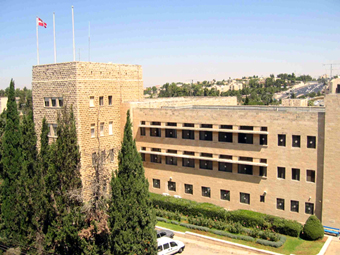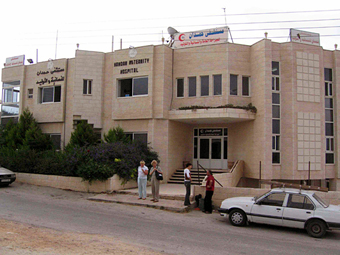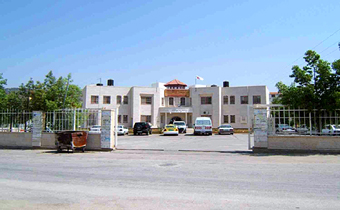 The United Religious, Military and Masonic Orders of the Temple and of St John of Jerusalem, Palestine, Rhodes and Malta in England and Wales and Provinces Overseas
The United Religious, Military and Masonic Orders of the Temple and of St John of Jerusalem, Palestine, Rhodes and Malta in England and Wales and Provinces OverseasProvince of Kent
 The St John of Jerusalem Eye Hospital
The St John of Jerusalem Eye Hospital
 The Templar knights of Kent enthusiastically support the chosen charity of Great Priory. This page outlines the main functions and activities of the charity. If you want more details, click on the link below to take you to their own website.
The Templar knights of Kent enthusiastically support the chosen charity of Great Priory. This page outlines the main functions and activities of the charity. If you want more details, click on the link below to take you to their own website.The majority of patients come from the West Bank, Gaza and East Jerusalem. Unforunately, access to specialist healthcare is limited, and most cannot move freely to see family or friends. Nearly half live below the poverty line.
Eye disease causing blindness is ten times more common in this region than in developed countries. 30% of the population is under the age of ten, with common conditions being squint, infantile glaucoma, cataract and trauma. In adults, cataract, glaucoma and the complications of diabetes are the main blinding conditions. Up to 80% of all blindness is preventable.
We treat patients regardless of race, religion, or ability to pay.


The Main Hospital
 The main Hospital in East Jerusalem is ISO accredited. It has a 49-bed capacity and is staffed by both foreign and local specialist surgeons, doctors, paramedics, overseas medical volunteers and nurses. There is a large, modern Outpatients Department and very busy specialist Retinal, Corneal and Paediatric services. The operating theatre, with the most modern equipment, provides a 24-hour emergency service, where all kinds of major eye surgery are performed.
The main Hospital in East Jerusalem is ISO accredited. It has a 49-bed capacity and is staffed by both foreign and local specialist surgeons, doctors, paramedics, overseas medical volunteers and nurses. There is a large, modern Outpatients Department and very busy specialist Retinal, Corneal and Paediatric services. The operating theatre, with the most modern equipment, provides a 24-hour emergency service, where all kinds of major eye surgery are performed.
Due to restrictions on employment and general movement of staff and patients by the Authorities treatment is not easy. The Hospital attracts a substantial number of volunteer doctors from around the world who not only care for the patients but also help in the teaching and training of the local doctors. The international surgeons cover certain sub-specialties. Our aim is, in time, are teaching programmes that will help make this provision less necessary.
Each year, nearly 40,000 patients are treated at the main Hospital. The dedicated team of medical staff and volunteers are helping to reduce suffering both now and in the future.
There is also a research unit.
 The main Hospital in East Jerusalem is ISO accredited. It has a 49-bed capacity and is staffed by both foreign and local specialist surgeons, doctors, paramedics, overseas medical volunteers and nurses. There is a large, modern Outpatients Department and very busy specialist Retinal, Corneal and Paediatric services. The operating theatre, with the most modern equipment, provides a 24-hour emergency service, where all kinds of major eye surgery are performed.
The main Hospital in East Jerusalem is ISO accredited. It has a 49-bed capacity and is staffed by both foreign and local specialist surgeons, doctors, paramedics, overseas medical volunteers and nurses. There is a large, modern Outpatients Department and very busy specialist Retinal, Corneal and Paediatric services. The operating theatre, with the most modern equipment, provides a 24-hour emergency service, where all kinds of major eye surgery are performed.Due to restrictions on employment and general movement of staff and patients by the Authorities treatment is not easy. The Hospital attracts a substantial number of volunteer doctors from around the world who not only care for the patients but also help in the teaching and training of the local doctors. The international surgeons cover certain sub-specialties. Our aim is, in time, are teaching programmes that will help make this provision less necessary.
Each year, nearly 40,000 patients are treated at the main Hospital. The dedicated team of medical staff and volunteers are helping to reduce suffering both now and in the future.
There is also a research unit.
Gaza Clinic
 The Gaza Clinic has been operating since 1992. It is, in fact, a mini Hospital, with the same standards of care as the main Hospital in Jerusalem, and conducts a busy Outpatients' Department and performs day case surgery.
The Gaza Clinic has been operating since 1992. It is, in fact, a mini Hospital, with the same standards of care as the main Hospital in Jerusalem, and conducts a busy Outpatients' Department and performs day case surgery.
The Gaza Strip is one of the most troubled and disadvantaged areas in the world. The small team are often required to go to great lengths to deliver medical support. Public services in this region are on the verge of collapse and our team are operating in what is really an emergency situation.
Despite this, the doctors managed to treat 17,005 patients in 2007, an increase of over 25% compared to the previous year and more than ever before. The Eye Hospital has continued its commitment to our Gaza patients. Despite the immense difficulties and the danger faced daily by our staff, St Johns Gaza Clinic has remained open. As the crisis continues, we have to do even more. Borders are shut, and our patients prevented from seeking medical assistance outside have nowhere else to go. If you would like to donate funds specifically to help in this very troubled area of the world, please go to the hospital web site Gaza donate.
 The Gaza Clinic has been operating since 1992. It is, in fact, a mini Hospital, with the same standards of care as the main Hospital in Jerusalem, and conducts a busy Outpatients' Department and performs day case surgery.
The Gaza Clinic has been operating since 1992. It is, in fact, a mini Hospital, with the same standards of care as the main Hospital in Jerusalem, and conducts a busy Outpatients' Department and performs day case surgery.The Gaza Strip is one of the most troubled and disadvantaged areas in the world. The small team are often required to go to great lengths to deliver medical support. Public services in this region are on the verge of collapse and our team are operating in what is really an emergency situation.
Despite this, the doctors managed to treat 17,005 patients in 2007, an increase of over 25% compared to the previous year and more than ever before. The Eye Hospital has continued its commitment to our Gaza patients. Despite the immense difficulties and the danger faced daily by our staff, St Johns Gaza Clinic has remained open. As the crisis continues, we have to do even more. Borders are shut, and our patients prevented from seeking medical assistance outside have nowhere else to go. If you would like to donate funds specifically to help in this very troubled area of the world, please go to the hospital web site Gaza donate.
Hebron Hospital
 The Hebron facility was opened in November 2005 on one floor of the Dahyiet El Zaitoun Hospital in the south of the city in order to reach patients in the densely populated areas around Hebron and Bethlehem.
The Hebron facility was opened in November 2005 on one floor of the Dahyiet El Zaitoun Hospital in the south of the city in order to reach patients in the densely populated areas around Hebron and Bethlehem.
The West Bank is subjected to a severe and complex system of movement restrictions, and the construction of the Separation Wall is creating even more serious implications. The Hebron Governorate is particularly affected due the presence of around 700 Israeli settlers who live in fortified enclaves within the city. Such restrictions have had a disastrous effect upon the health of the half a million Palestinian residents, both directly by preventing people from accessing health care, and indirectly by adversely affecting the Hebron economy, resulting in decreased living standards and in peoples ability to afford health care.
Since opening, the number of patients being seen at Hebron has doubled and we have taken over a second floor of the Dahyiet El Zaitoun building. In 2008, Chairman John Talbot upgraded the centres status to that of a Hospital in its own right. All residents of the Hebron Governorate, as well as the Negev Bedouins, directly benefit from the presence of the Hospital.
In 2008, 13,842 patients were treated in Hebron and close to 700 sight-saving operations were performed.
 The Hebron facility was opened in November 2005 on one floor of the Dahyiet El Zaitoun Hospital in the south of the city in order to reach patients in the densely populated areas around Hebron and Bethlehem.
The Hebron facility was opened in November 2005 on one floor of the Dahyiet El Zaitoun Hospital in the south of the city in order to reach patients in the densely populated areas around Hebron and Bethlehem.The West Bank is subjected to a severe and complex system of movement restrictions, and the construction of the Separation Wall is creating even more serious implications. The Hebron Governorate is particularly affected due the presence of around 700 Israeli settlers who live in fortified enclaves within the city. Such restrictions have had a disastrous effect upon the health of the half a million Palestinian residents, both directly by preventing people from accessing health care, and indirectly by adversely affecting the Hebron economy, resulting in decreased living standards and in peoples ability to afford health care.
Since opening, the number of patients being seen at Hebron has doubled and we have taken over a second floor of the Dahyiet El Zaitoun building. In 2008, Chairman John Talbot upgraded the centres status to that of a Hospital in its own right. All residents of the Hebron Governorate, as well as the Negev Bedouins, directly benefit from the presence of the Hospital.
In 2008, 13,842 patients were treated in Hebron and close to 700 sight-saving operations were performed.
Anabta Centre
 On 23rd April 2007, the Anabta Eye Centre opened its doors to patients for the very first time. This is the third satellite clinic in the North of the West Bank and will be able to reach almost all of the West Bank towns, villages and refugee camps.
On 23rd April 2007, the Anabta Eye Centre opened its doors to patients for the very first time. This is the third satellite clinic in the North of the West Bank and will be able to reach almost all of the West Bank towns, villages and refugee camps.
The Anabta clinic caters for close to a million patients in the isolated North of the West Bank. Over the coming twelve months we look forward to developing further our newly opened Anabta Clinic in the North of the West Bank. At present the Centre is initiating a partnership with the Red Crescent Society, focusing on the treatment and referrals of diabetic patients, thereby intensifying the efforts in controlling this preventable blinding eye disease.
The Centre anticipates seeing close to 10,000 patients in 2008.
 On 23rd April 2007, the Anabta Eye Centre opened its doors to patients for the very first time. This is the third satellite clinic in the North of the West Bank and will be able to reach almost all of the West Bank towns, villages and refugee camps.
On 23rd April 2007, the Anabta Eye Centre opened its doors to patients for the very first time. This is the third satellite clinic in the North of the West Bank and will be able to reach almost all of the West Bank towns, villages and refugee camps.The Anabta clinic caters for close to a million patients in the isolated North of the West Bank. Over the coming twelve months we look forward to developing further our newly opened Anabta Clinic in the North of the West Bank. At present the Centre is initiating a partnership with the Red Crescent Society, focusing on the treatment and referrals of diabetic patients, thereby intensifying the efforts in controlling this preventable blinding eye disease.
The Centre anticipates seeing close to 10,000 patients in 2008.
Mobile Outreach
 Now that the Separation Wall is nearly complete, travel to East Jerusalem and the Hospital is very expensive and difficult, especially for the very young and very old patients.
Now that the Separation Wall is nearly complete, travel to East Jerusalem and the Hospital is very expensive and difficult, especially for the very young and very old patients.
There is therefore an even greater need for the Mobile Outreach Clinics, which first started work in 1982. They have become a well-known sight in the remote towns, villages and refugee camps of the West Bank.
There are two teams, one of which is funded by ECHO (European Community Humanitarian Aid Office). They start at 7.30 every morning and return after dark. They are often held up at military checkpoints or even turned back and not allowed to enter a particular village – where generally 50-60 patients are waiting expectantly for their arrival. But their motto – we will get through – usually means that they find a way around the many obstacles they face.
Each year, the mobile outreach teams see in the region of 12,000 patients, nearly one third being under the age of ten.
 Now that the Separation Wall is nearly complete, travel to East Jerusalem and the Hospital is very expensive and difficult, especially for the very young and very old patients.
Now that the Separation Wall is nearly complete, travel to East Jerusalem and the Hospital is very expensive and difficult, especially for the very young and very old patients.There is therefore an even greater need for the Mobile Outreach Clinics, which first started work in 1982. They have become a well-known sight in the remote towns, villages and refugee camps of the West Bank.
There are two teams, one of which is funded by ECHO (European Community Humanitarian Aid Office). They start at 7.30 every morning and return after dark. They are often held up at military checkpoints or even turned back and not allowed to enter a particular village – where generally 50-60 patients are waiting expectantly for their arrival. But their motto – we will get through – usually means that they find a way around the many obstacles they face.
Each year, the mobile outreach teams see in the region of 12,000 patients, nearly one third being under the age of ten.
Training and Teaching
 The Hospital believes that teaching and training local doctors and nurses is one of the most important things that they can do.
The Hospital believes that teaching and training local doctors and nurses is one of the most important things that they can do.
That is why the Hospital has a four-year Medical Residency Training Programme. It is recognised by the Palestinian and Jordanian Boards of Ophthalmology and the first two years are recognised by the British Royal College of Ophthalmologists. Five resident doctors are on this programme at the moment.
In 2008, a Joint Co-operation Programme with the world-renowned Hadassah Medical Centre in Israel, had three Palestinian doctors studying to take the Israeli Board of Ophthalmology. They also provided students from the Al-Quds University Medical School with undergraduate teaching in Ophthalmology.
Nurse training is equally vitally important. The Sir Steven Miller School of Nursing conducts a one year Specialist Ophthalmic Nursing Course, which is accredited by Thames Valley University. In addition, these nurses may go on to train as Ophthalmic Nurse Practitioners who work alongside the medical staff in the Hospital, Outreach clinics and static eye centres in the community.
 The Hospital believes that teaching and training local doctors and nurses is one of the most important things that they can do.
The Hospital believes that teaching and training local doctors and nurses is one of the most important things that they can do.That is why the Hospital has a four-year Medical Residency Training Programme. It is recognised by the Palestinian and Jordanian Boards of Ophthalmology and the first two years are recognised by the British Royal College of Ophthalmologists. Five resident doctors are on this programme at the moment.
In 2008, a Joint Co-operation Programme with the world-renowned Hadassah Medical Centre in Israel, had three Palestinian doctors studying to take the Israeli Board of Ophthalmology. They also provided students from the Al-Quds University Medical School with undergraduate teaching in Ophthalmology.
Nurse training is equally vitally important. The Sir Steven Miller School of Nursing conducts a one year Specialist Ophthalmic Nursing Course, which is accredited by Thames Valley University. In addition, these nurses may go on to train as Ophthalmic Nurse Practitioners who work alongside the medical staff in the Hospital, Outreach clinics and static eye centres in the community.
Research at the Eye Hospital Group Behet's Disease
Behcet's Disease is a chronic condition in which the body's immune system, which normally protects the body against infections, becomes over-active. It causes inflammation of different parts of the body, which may flare up without warning and can occur wherever there is a blood supply. Small blood vessels are particularly affected, and inflammation can appear in patches in areas where there are clusters of small blood vessels. Where this occurs in the body dictates the symptoms a person experiences.
Behcet's Disease generally begins when a person is in their 20s or 30s. It is rare in the UK and more common in Mediterranean countries, Turkey, the Middle East, Japan and South-East Asia.
The condition can result in skin lesions and also affects the joints, all types of vessels, lungs, central nervous system and digestive tract. Behcet's Disease is characterized by recurrent oral and /or genital ulcerations, and inflammation of the eyes (Uveitis).
The management of Behcet's Disease remains problematic due to the still incomplete knowledge of the disease mechanisms determining its course in individual patients (Hatemi et al., Ann Rheum Dis. 2008).
Thus the collection of clinical, as well as genetic data, from patients with Behcet's Disease referred to the St John Eye Hospital Group constitutes an important source of medical research.
Research is conducted in collaboration with the Rheumatology unit at Hadassah Medical Center in East Jerusalem and is supported by the Ridley foundation in London. The recent acquisition of advanced imaging technology (spectral OCT) through a grant from the Japanese government has enhanced our capabilitiy to assess complications of Behcet's disease and correlate ocular inflammation with genetic risk factors.
Behcet's Disease is a chronic condition in which the body's immune system, which normally protects the body against infections, becomes over-active. It causes inflammation of different parts of the body, which may flare up without warning and can occur wherever there is a blood supply. Small blood vessels are particularly affected, and inflammation can appear in patches in areas where there are clusters of small blood vessels. Where this occurs in the body dictates the symptoms a person experiences.
Behcet's Disease generally begins when a person is in their 20s or 30s. It is rare in the UK and more common in Mediterranean countries, Turkey, the Middle East, Japan and South-East Asia.
The condition can result in skin lesions and also affects the joints, all types of vessels, lungs, central nervous system and digestive tract. Behcet's Disease is characterized by recurrent oral and /or genital ulcerations, and inflammation of the eyes (Uveitis).
The management of Behcet's Disease remains problematic due to the still incomplete knowledge of the disease mechanisms determining its course in individual patients (Hatemi et al., Ann Rheum Dis. 2008).
Thus the collection of clinical, as well as genetic data, from patients with Behcet's Disease referred to the St John Eye Hospital Group constitutes an important source of medical research.
Research is conducted in collaboration with the Rheumatology unit at Hadassah Medical Center in East Jerusalem and is supported by the Ridley foundation in London. The recent acquisition of advanced imaging technology (spectral OCT) through a grant from the Japanese government has enhanced our capabilitiy to assess complications of Behcet's disease and correlate ocular inflammation with genetic risk factors.
The impact of the Eye Hospital Groups
investigations into Behcet's Disease is given further authority by ongoing participation in the international multi-centre study coordinated by Professor Miles Stanford in London.
Professor Stanford is a clinical academic with a major interest in inflammation and the eye. He trained at St Thomas and Kings College Hospitals and has been involved in clinical and basic research into the causes and treatment of ocular inflammation for the last 20 years and currently runs dedicated tertiary referral clinics at St Thomas' Hospital for the diagnosis and treatment of these disorders. His major interests are in the epidemiology of ocular toxoplasmosis and the immunogenetics of ocular inflammation.
For further information and up-to-date news, visit the The St John of Jerusalem Eye Hospital website: www.stjohneyehospital.orginvestigations into Behcet's Disease is given further authority by ongoing participation in the international multi-centre study coordinated by Professor Miles Stanford in London.
Professor Stanford is a clinical academic with a major interest in inflammation and the eye. He trained at St Thomas and Kings College Hospitals and has been involved in clinical and basic research into the causes and treatment of ocular inflammation for the last 20 years and currently runs dedicated tertiary referral clinics at St Thomas' Hospital for the diagnosis and treatment of these disorders. His major interests are in the epidemiology of ocular toxoplasmosis and the immunogenetics of ocular inflammation.